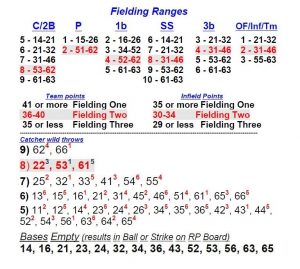The Fielding Range Chart does more than identify the three different Fielding ratings.
It also tracks RP results on Bases Empty and Catcher wild throws on safe steals. For the more ambitious, it also tracks Dropped Throws on Stealing Tags.
First the RP Bases Empty. This saves having to consult the RP board, with the bases empty, only to find that the result is a Ball, Strike, or Foul Ball. Big time-saver; but, remember, this only applies to Bases Empty. With men on base, everything is a potential play, so you have to look it up.
Here’s an example.
Using Andrew McCutchen’s 2015 season card, you roll a 35, which results in 40. Rather than trudge to the RP board to get the result, simply roll the dice and if any one of the 14 numbers that result in a Ball, Strike, or Foul Ball come up, you know instantly that there is no play result. You can then re-roll until a play result number surfaces.
So what happens if you roll three strikes or four balls in a row?
The odds of a strikeout or base on balls occurring with this are infinitesimal. I’ve never had it happen in more than 10,000 games.
Next: Tracking catcher’s wild throws





Hi Rod,
Great post – love these articles! You mention “For the more ambitious, it also tracks Dropped Throws on Stealing Tags” – I don’t see this on the file/.pdf. Is this posted somewhere else?
Thanks,
Larry